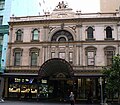Royal Arcade, Melbourne


The Royal Arcade is a historic shopping arcade in the central business district of Melbourne, Victoria, Australia.[1] Opened in 1870,[2] it connects Bourke Street Mall to Little Collins Street, with a side offshoot to Elizabeth Street. It is the oldest surviving arcade in Australia, known for its elegant light-filled interior, and the large carved mythic figures of Gog and Magog flanking the southern entry.
Along with Melbourne's other Victorian era arcade, the nearby Block Arcade, it is a tourist icon of the city, and forms part of the network of lanes and arcades in the CBD.
The arcade is listed on the Victorian Heritage Register,[1] as well as by the National Trust of Australia. It also forms part of Melbourne's Golden Mile heritage walk.[3]
History[edit]

Designed by Charles Webb, who won a competition in 1868, the arcade features a high glass roof and rows of arched windows to the storerooms above each shop. It was formally opened by the City Lord Mayor on 2 May, 1870.[4]
The arcade's most famous features were added in 1893; at the south end, the carved mythical figures of Gog and Magog (based on those in London's Guildhall), flank the large 'Gaunt's clock', which triggers the arms of the figures to strike bells each hour,[5] while the north end features a figure of Father Time.[6][7][8][9] Gaunt was Melbourne's best known clock-maker at the time.
The arcade originally ended at the south end, with an entrance to a Turkish Bath,[4] but this was opened up to Little Collins Street in 1902, along with the creation of the large arched niche, and in the same year an extension was added to the west side through to Elizabeth Street . The shopfronts were all changed into bow fronted windows in 1890-1894, later many altered again, various central kiosks were added, and the black and white chequered floor laid in 1934.[10] In the 1920s, the cast iron verandah was removed, but was recreated in the 1990s.
In 2002-04 a major refurbishment and restoration included the recreation the 1894 shopfronts, bringing a consistency to the shopfronts once more.[2] In c2010, the facade was repainted in a yellow and white colour scheme, with gilded highlights.
Access[edit]
The arcade's main entry faces Bourke Street, and it connects south through to Little Collins Street, with an extension in the centre running west to Elizabeth Street. There is also a connection to the smaller Hub Arcade near the Little Collins Street end.
Gallery[edit]
-
The Bourke Street Mall facade in 2006
-
Southern end featuring Gog and Magog statues, and Gaunt's clock
-
Sculpture of Father Time
-
Bow fronted shopfronts
See also[edit]
References[edit]
- ^ a b "Royal Arcade, Victorian Heritage Register (VHR) Number H0023, Heritage Overlay HO543". Victorian Heritage Database. Heritage Victoria. Retrieved 6 April 2011.
- ^ a b "History". Royal Arcade Melbourne. Royal Arcade. Retrieved 3 October 2016.
- ^ "Melbourne's Golden Mile Heritage Trail". Tourism Victoria. Retrieved 25 July 2011.
- ^ a b "The Royal Arcade". Argus (Melbourne, Vic. : 1848 - 1957). 3 May 1870. p. 7. Retrieved 26 March 2019.
- ^ "GOG and MAGOG". Herald (Melbourne, Vic. : 1861 - 1954). 3 April 1937. p. 36. Retrieved 26 March 2019.
- ^ "Melbourne Gossip". The Bendigo Independent. 30 May 1893. Retrieved 3 October 2016.
- ^ The figures are said to be based on the 1708 figures in the Guildhall in London, but their use as figures to strike the time may have been inspired by another carved pair of Gog and Magog erected on the outside of Bennett's Clock Shop in Cheapside by 1891, which also struck the hour and included a figure of Father Time. The lower part of the shop complete with the figures are now part of the Henry Ford Museum, Dearborn, Michigan
- ^ "A Melbourne Landmark". The Age. 7 January 1950. p. 8. Retrieved 26 March 2019.
- ^ "Melbourne's Unique Clock". Herald (Melbourne, Vic. : 1861 - 1954). 22 February 1930. p. 19. Retrieved 26 March 2019.
- ^ "Royal Arcade". Victorian Heritage Database. Heritage Victoria. Retrieved 3 October 2016.




